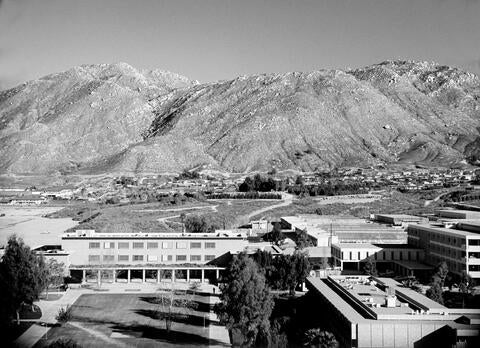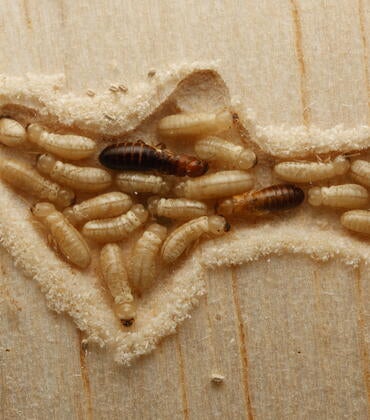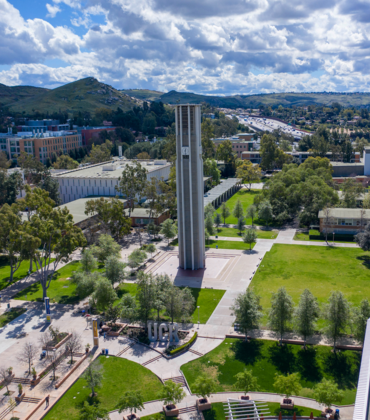
Mule deer, hummingbirds and spiny lizards are only a few of the species living in Box Springs Mountain Park, a 3,400-acre expanse that almost became condos. This year, the park celebrates 50 years as a testament to community-driven conservation efforts near UC Riverside.
“The park is an amazing resource. It offers miles of trails on hilly terrain ranging from challenging to easy, and spectacular views,” said UCR Senior Public Information Officer David Danelski, who has lived in Riverside since 1990.
“On a good day, you can see as far as Mexico, with trailheads that start right by UCR. It offers an amazing escape from urban life, even though you don’t have to travel far to get there,” Danelski said.
The story of the park’s establishment is one of ordinary citizens taking extraordinary action to protect the natural beauty and integrity of the Box Springs Mountains. In the early 1970s, Richard and Jane Block, along with local citrus grower Mary Cassina, were hiking on the mountain when they learned of plans to subdivide and develop the land. Block, who was a math professor at UCR, realized that preserving the mountain would require swift action.
“Once a parcel is divided and sold, the opportunity to save it as open space is gone forever,” Block said.
Characterized by sweeping rock formations, native plants, and wildlife, the Box Springs were at risk of being fragmented by roads as well as home sites. Block and his colleagues formed the Box Springs Mountains Conservation Association, which rallied the community to advocate for a county park instead of housing developments.
At that time, Riverside County had access to a new Joint Powers funding package, a financial tool that allowed local and regional government agencies to pool resources for shared projects. This funding was crucial in helping the county acquire key parcels of land for preservation.
Using these funds, the grassroots movement secured 200 acres from developer Bruce Winship, 120 acres from local landowner Helene “Hermit” Arlington, and substantial land donations from Stanley Flanders, a retired UC Riverside entomology professor. These acquisitions laid the groundwork for what would become Box Springs Mountain Park.
On April 5, 1975, Riverside County officially dedicated the park, and later held a celebration with music, dancing, and horseback riders. Since then, the park has grown to encompass 3,400 acres, with Friends of Riverside’s Hills, a local environmental group, playing a vital role in acquiring additional land and protecting vital wildlife corridors.
“History is essential as we look to the future, and our community owes a great deal of gratitude to the Friends of Riverside’s Hills,” said Riverside City Councilmember Clarissa Cervantes. “The nonprofit was founded by residents, professors, researchers, and environmentalists who advocate for the Box Springs Mountain Park. Their work has been critical to protecting the open space that we all enjoy today.”
Today, the park is more than a scenic retreat. It serves as a vital ecological reserve under the Western Riverside County Multiple Species Habitat Conservation Plan, protecting habitats for deer, bobcats, mountain lions, and 19 species of reptiles. Birdwatchers are often rewarded with sightings of red-tailed hawks, turkey vultures, and the majestic golden eagle soaring overhead.
The park also functions as a living laboratory for UCR faculty and students, whose research in ecology and environmental science is enhanced by access to a protected natural landscape adjacent to the university’s own Natural Land Reserve – site of the giant letter “C” visible from many vantage points on campus.
Erin Wilson Rankin, UCR entomology professor, shared that she and her doctoral students have conducted many research projects in the park. One current project examines the way herbivores and pollinator insects interact with native mallow plants. Another project looked at the way the park’s plants responded to the 2017 Blaine Fire. Her husband, UCR biologist David Rankin, has also studied hummingbird behavior on the mountain.
“Box Springs is a fantastic resource right in the middle of urban Riverside--there is always something to see--whether it's the wildflower blooms, nesting birds, braying donkeys or the occasional bobcat,” Wilson Rankin said.
Despite its size and significance, the work of preserving the land must continue. Norton Younglove, the county supervisor instrumental in establishing the park, passed away recently, and even though Richard and Jane Block continue to champion conservation efforts there, they are now in their mid-90s.
“The mountain’s future depends on continued vigilance,” said Jane Block, reflecting on the decades-long effort to protect the park.
Plans for the future include securing additional parcels to connect existing wildlife corridors, protecting the area from further encroachment, and enhancing public access with new amenities and educational programs. Friends of Riverside’s Hills continue to advocate for conservation funding and responsible stewardship of the park’s resources.
“What we have is something rare and precious, a natural sanctuary preserved in the midst of the urban Riverside-Moreno Valley area,” said Richard Block. “It’s not just a park; it’s a reminder of what a community can achieve when it works together to protect its natural heritage.”
Cervantes, a lifelong Riverside County resident, echoed these sentiments. “I would never want to imagine a world or a Riverside where the park does not exist. It truly is irreplaceable and there is no value that can be placed on how significant it is to our future,” she said.
(Cover image: David Rankin/UCR)






